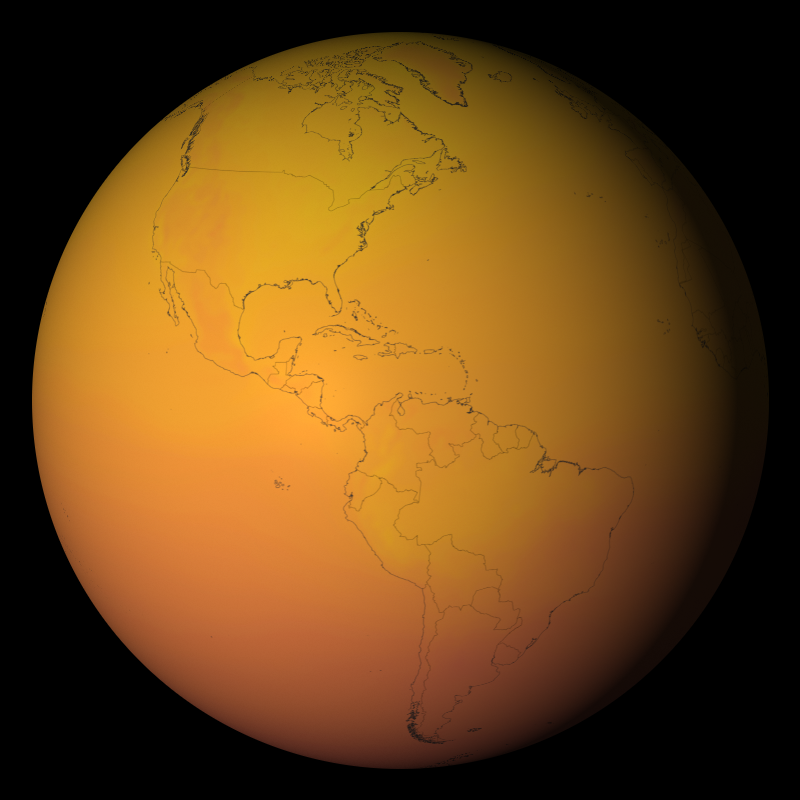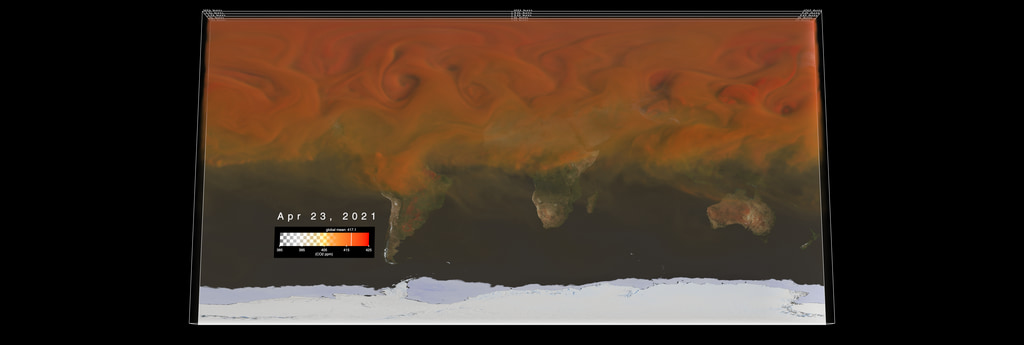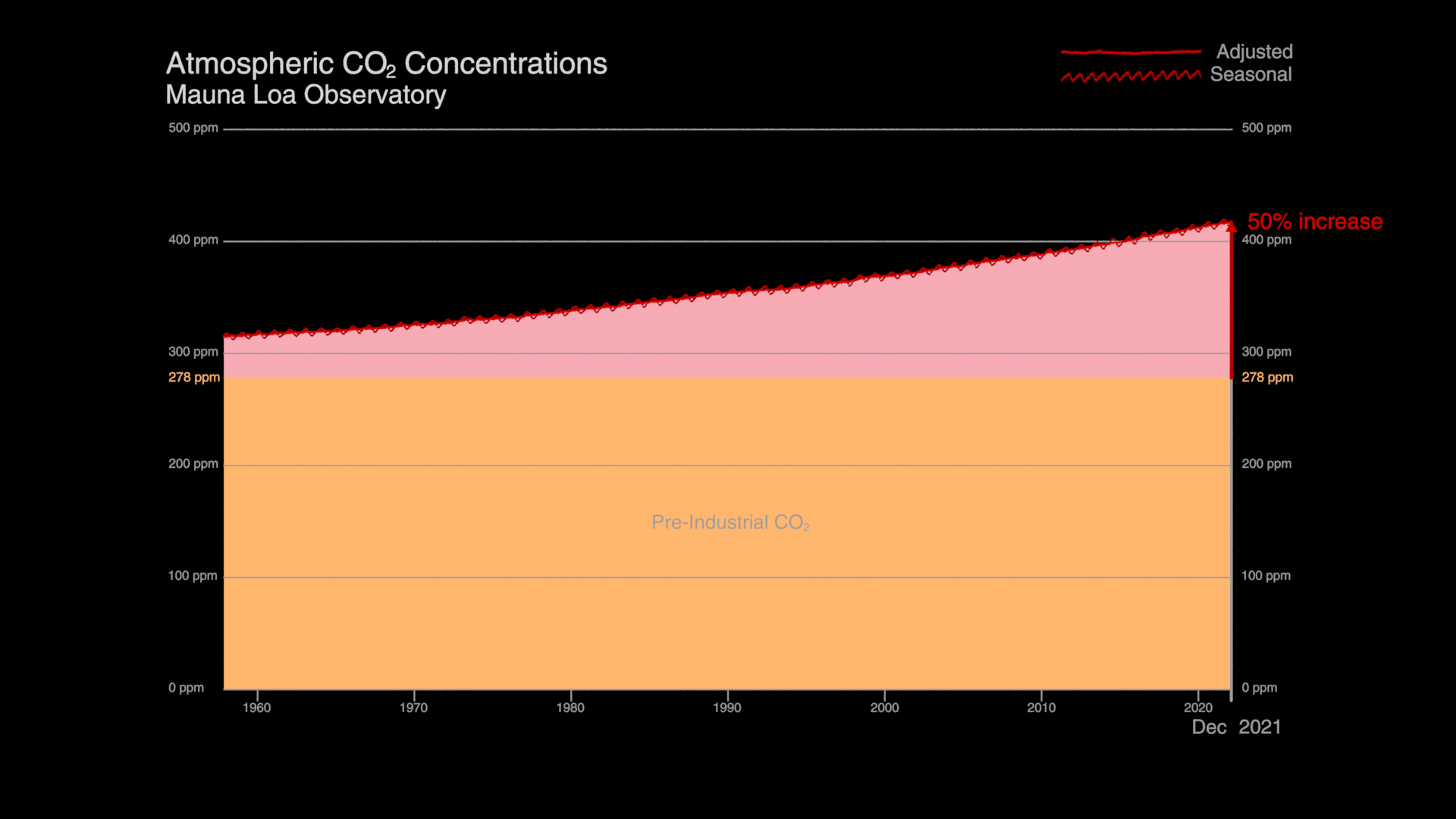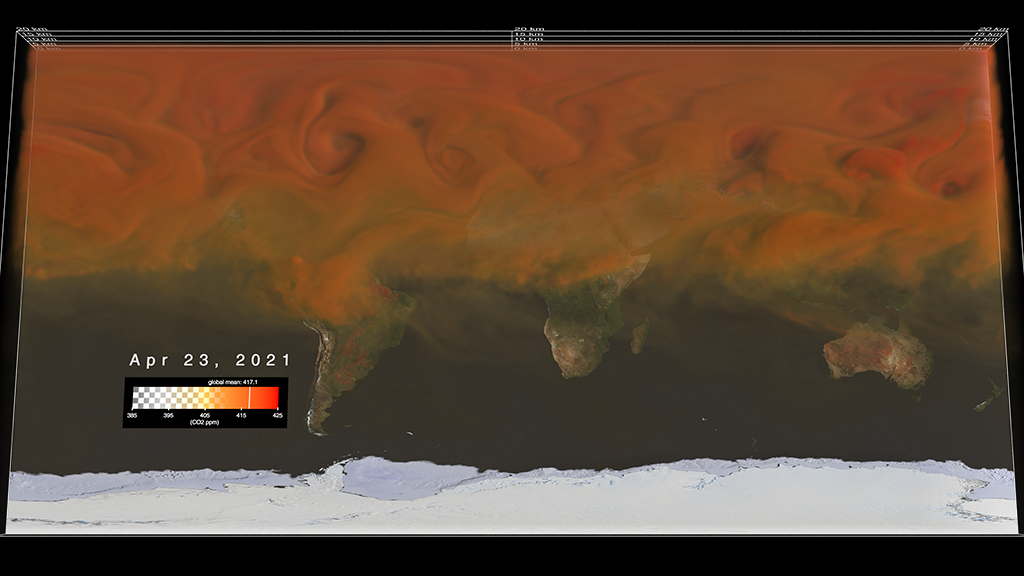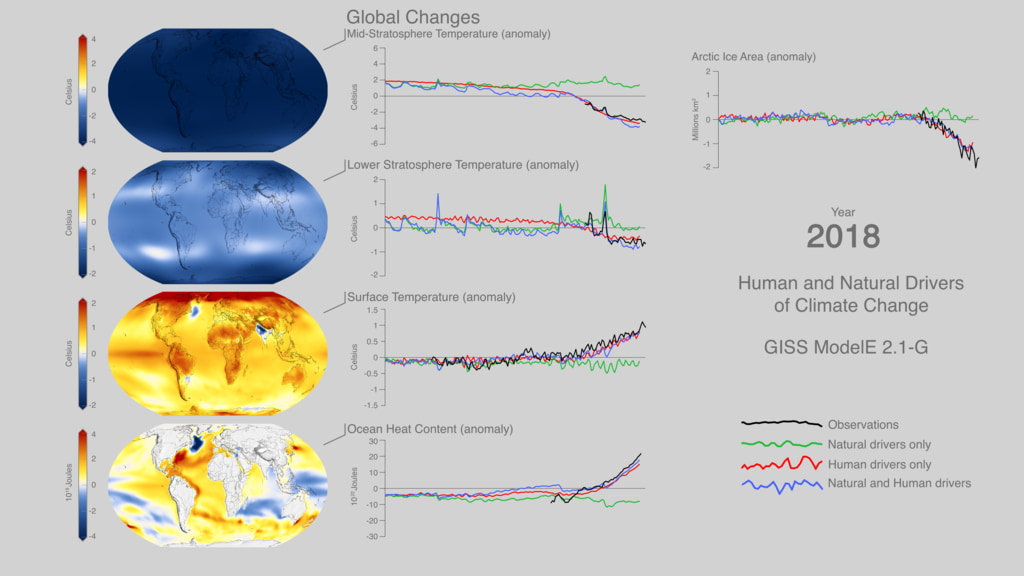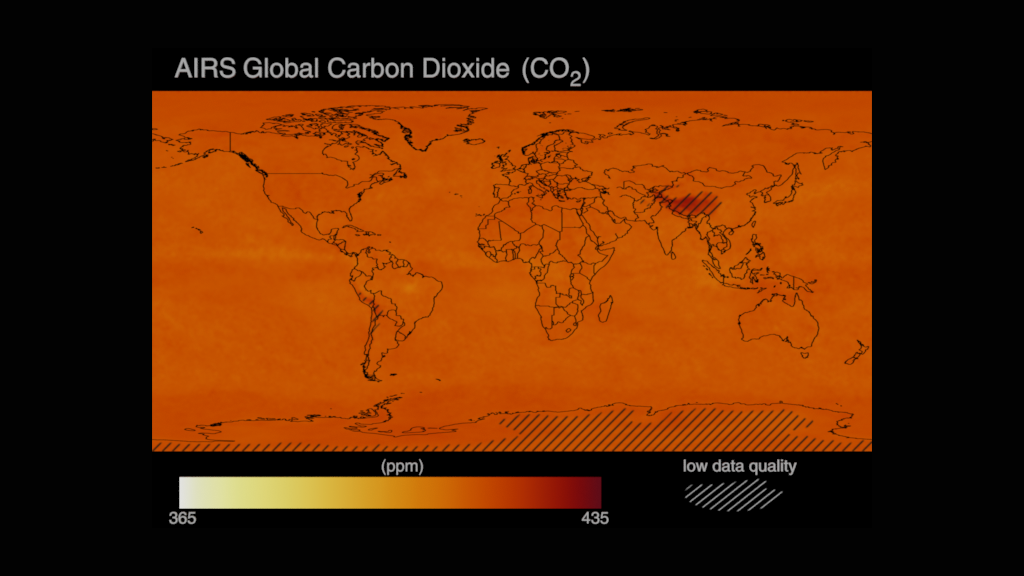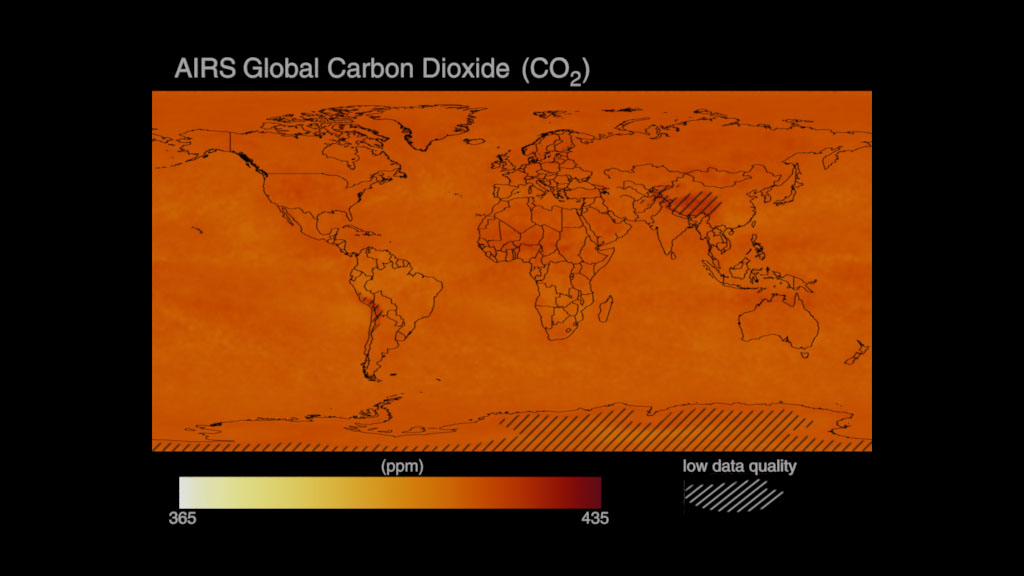A newer version of this visualization is available.
20 years of AIRS Global Carbon Dioxide (CO₂) measurements (2002-May 2022)
Data visualization of global carbon dioxide (CO₂) for the period September 2002-May 2022, showcasing data products from NASA's Aqua mission. Data visualization assets are designed for HD resolution.
This data visualization shows the global distribution and variation of the concentration of mid-tropospheric carbon dioxide observed by the Atmospheric Infrared Sounder (AIRS) on the NASA Aqua spacecraft over a 20 year timespan. One obvious feature that we see in the data is a continual increase in carbon dioxide with time, as seen in the shift in the color of the map from light yellow towards red as time progresses. Another feature is the seasonal variation of carbon dioxide in the northern hemisphere, which is governed by the growth cycle of plants. This can be seen as a pulsing in the colors, with a shift towards lighter colors starting in April/May each year and a shift towards red as the end of each growing season passes into winter. The seasonal cycle is more pronounced in the northern hemisphere than the southern hemisphere, since the majority of the land mass is in the north.
The visualization includes a data-driven spatial map of global carbon dioxide and a timeline on the bottom. The timeline showcases the monthly timestep and is paired with the adjusted carbon dioxide value. Areas where the air pressure is less than 750mB (areas of high-altitude) have been marked in the visualization as low data quality (striped) areas. This entry offers two versions of low data quality (stiped) areas. One version includes striped regions as they are calculated on data values and the second version features striped regions below 60 South.
Data Sources:
- Carbon Dioxide (CO2) from the Sounder SIPS: AQUA AIRS IR-only Level 3 CLIMCAPS: Comprehensive Quality Control Gridded Monthly V2 (SNDRAQIL3CMCCP), which is a monthly product of global coverage and of spatial resolution 1x1 degrees.
The visualizations included on this page, utilize the variable co2_vmr_uppertop from the CLIMCAPS product. Areas where the air pressure is less than 750mB (areas of high-altitude) and below 60 degrees South have been marked in the visualization as low data quality (striped areas). In addition, areas with data gaps and of high altitude less than 5% of the resolution of the product have been filled using the nearest neighbor algorithm.
Citation: Chris Barnet (2019), Sounder SIPS: AQUA AIRS IR-only Level 3 CLIMCAPS: Comprehensive Quality Control Gridded Monthly V2, Greenbelt, MD, USA, Goddard Earth Sciences Data and Information Services Center (GES DISC), Accessed: [September 9, 2022], doi: 10.5067/ZPZ430KOPMIX - Trends in Atmospheric Carbon Dioxide by NOAA. The visualizations on this page feature de-seasonalized mean value measurements from the Mauna Loa CO2 monthly mean data for the period September 2002-May 2022, Accessed: [September 9 2022].
Citation: Dr. Pieter Tans, NOAA/GML (gml.noaa.gov/ccgg/trends/) and Dr. Ralph Keeling, Scripps Institution of Oceanography (scrippsco2.ucsd.edu).
Citation: Keeling, Ralph F; Keeling, Charles D. (2017). Atmospheric Monthly In Situ CO2 Data - Mauna Loa Observatory, Hawaii (Archive 2021-09-07). In Scripps CO2 Program Data. UC San Diego Library Digital Collections. https://doi.org/10.6075/J08W3BHW - Continental and country outlines from the Scientific Visualization Studio, NASA/GSFC.
The rest of this webpage offers custom versions for web, HD and 4K display systems.
climate.nasa.gov
This section contains assets designed for climate.nasa.gov
Data visualization of global carbon dioxide (CO₂) for the period September 2002-May 2022, showcasing data products from NASA's Aqua mission. Data visualization assets are designed for 720x586 resolution for climate.nasa.gov

Monthly frames (720x480 resolution) of global carbon dioxide (CO₂) for the period September 2002-May 2022, showcasing data products from NASA's Aqua mission. Each frame represents a montly timestep for the period September 2002-May 2022.
The CO2_frames_dates_values.csvcan be used to sync frame number, date and CO₂ values.
Data visualization of global carbon dioxide (CO₂) for the period September 2002-May 2022, showcasing data products from NASA's Aqua mission. Data visualization assets are designed for 720x586 resolution for climate.nasa.gov

Monthly frames (720x480 resolution) of global carbon dioxide (CO₂) for the period September 2002-May 2022, showcasing data products from NASA's Aqua mission. Each frame represents a montly timestep for the period September 2002-May 2022.
The CO2_frames_dates_values.csv can be used to sync frame number, date and CO₂ values.
HD content
Additional visualization content in HD resolution.
Data visualization of global carbon dioxide (CO₂) for the period September 2002-May 2022, showcasing data products from NASA's Aqua mission. Data visualization assets are designed for HD resolution.
4K content
Data visualization of global carbon dioxide (CO₂) for the period September 2002-May 2022, showcasing data products from NASA's Aqua mission. Data visualization assets are designed for 4K resolution.
Data visualization of global carbon dioxide (CO₂) for the period September 2002-May 2022, showcasing data products from NASA's Aqua mission. Data visualization assets are designed for 4K resolution.
Colormap
The following section contains colormap information.

Colorbar created for the AIRS global carbon dioxide (CO2) visualization. White/yellow-to-red colormap (low-to-high values) to show the increase of global carbon dioxide over the years.
The stops and rgb values are available in the following .csv files:
Colormap in RGB(0, 1): 5025colormap_RGB_range0_1.csv
Colormap in RGB(0, 255): 5025colormap_RGB_range0_255.csv
Credits
Please give credit for this item to:
NASA's Scientific Visualization Studio
-
Visualizer
-
Helen-Nicole Kostis
(USRA)
-
Helen-Nicole Kostis
(USRA)
-
Scientist
- Vivienne H. Payne (Jet Propulsion Laboratory (JPL))
-
Outreach lead
- Sharon Ray (NASA/JPL CalTech)
-
Science editor
- Daniel Bailey (NASA/Jet Propulsion Laboratory (JPL))
-
Outreach coordinator
- Holly Shaftel (NASA/Jet Propulsion Laboratory (JPL))
-
Technical support
- Laurence Schuler (ADNET Systems, Inc.)
- Ian Jones (ADNET Systems, Inc.)
- Eric Sokolowsky (Global Science and Technology, Inc.)
Missions
This page is related to the following missions:Datasets used
-
Trends in Atmospheric Carbon Dioxide (Mauna Loa CO2 monthly mean data)
ID: 1133Credit: Dr. Pieter Tans, NOAA/GML (gml.noaa.gov/ccgg/trends/) and Dr. Ralph Keeling, Scripps Institution of Oceanography (scrippsco2.ucsd.edu/).
This dataset can be found at: https://gml.noaa.gov/ccgg/trends/data.html
See all pages that use this dataset -
SNDRAQIL3CMCCP (Sounder SIPS: AQUA AIRS IR-only Level 3 CLIMCAPS: Comprehensive Quality Control Gridded Monthly V2) [NASA AQUA: AIRS (Atmospheric Infrared Sounder)]
ID: 1143This dataset can be found at: https://doi.org/10.5067/ZPZ430KOPMIX
See all pages that use this dataset
Note: While we identify the data sets used on this page, we do not store any further details, nor the data sets themselves on our site.
Release date
This page was originally published on Wednesday, September 14, 2022.
This page was last updated on Sunday, March 2, 2025 at 12:13 AM EST.
